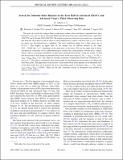Search for Subsolar-Mass Binaries in the First Half of Advanced LIGO’s and Advanced Virgo’s Third Observing Run
Author(s)
Sudhir, Vivishek
DownloadPublished version (549.1Kb)
Publisher Policy
Publisher Policy
Article is made available in accordance with the publisher's policy and may be subject to US copyright law. Please refer to the publisher's site for terms of use.
Terms of use
Metadata
Show full item recordAbstract
We report on a search for compact binary coalescences where at least one binary component has a mass between 0.2 $M_\odot$ and 1.0 $M_\odot$ in Advanced LIGO and Advanced Virgo data collected between 1 April 2019 1500 UTC and 1 October 2019 1500 UTC. We extend previous analyses in two main ways: we include data from the Virgo detector and we allow for more unequal mass systems, with mass ratio $q \geq 0.1$. We do not report any gravitational-wave candidates. The most significant trigger has a false alarm rate of 0.14 $\mathrm{yr}^{-1}$. This implies an upper limit on the merger rate of subsolar binaries in the range $[220-24200] \mathrm{Gpc}^{-3} \mathrm{yr}^{-1}$, depending on the chirp mass of the binary. We use this upper limit to derive astrophysical constraints on two phenomenological models that could produce subsolar-mass compact
objects. One is an isotropic distribution of equal-mass primordial black holes. Using this model, we find that the fraction of dark matter in primordial black holes is $f_\mathrm{PBH} \equiv \Omega_\mathrm{PBH} / \Omega_\mathrm{DM} \lesssim 6\%$. The other is a dissipative dark matter model, in which fermionic
dark matter can collapse and form black holes. The upper limit on the fraction of dark matter black holes depends on the minimum mass of the black holes that can be formed: the most constraining result is obtained at $M_\mathrm{min}=1 M_\odot$, where $f_\mathrm{DBH} \equiv \Omega_\mathrm{PBH} / \Omega_\mathrm{DM}
\lesssim 0.003\%$. These are the tightest limits on spinning subsolar-mass binaries to date.
Date issued
2022-08-05Department
LIGO (Observatory : Massachusetts Institute of Technology)Journal
Physical Review Letters
Publisher
American Physical Society
Citation
Sudhir, Vivishek. 2022. "Search for Subsolar-Mass Binaries in the First Half of Advanced LIGO’s and Advanced Virgo’s Third Observing Run." Physical Review Letters, 129 (6).
Version: Final published version
ISSN
0031-9007
1079-7114